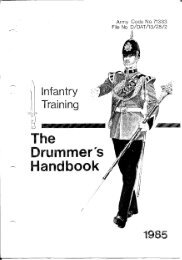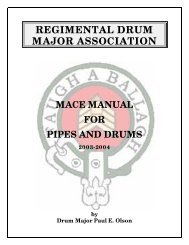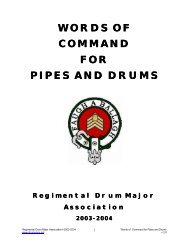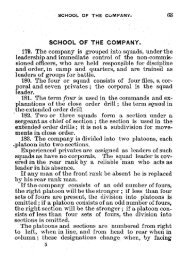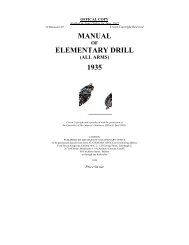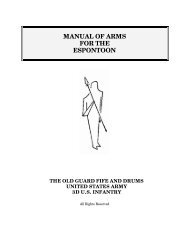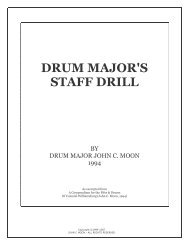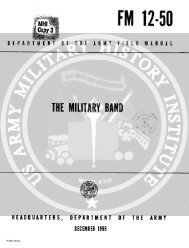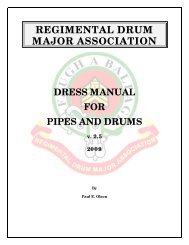Marine corps drill and ceremonies manual - Regimental Drum Major ...
Marine corps drill and ceremonies manual - Regimental Drum Major ...
Marine corps drill and ceremonies manual - Regimental Drum Major ...
You also want an ePaper? Increase the reach of your titles
YUMPU automatically turns print PDFs into web optimized ePapers that Google loves.
(1) When comm<strong>and</strong>s such as FALL OUT are given, which combine the<br />
preparatory comm<strong>and</strong> <strong>and</strong> comm<strong>and</strong> of execution.<br />
(2) When the preparatory comm<strong>and</strong> of the company comm<strong>and</strong>er is<br />
COMPANY, the platoon comm<strong>and</strong>ers give the preparatory comm<strong>and</strong><br />
PLATOON.<br />
(3) When in mass formation, platoon comm<strong>and</strong>ers repeat preparatory<br />
comm<strong>and</strong>s only when the order will require independent movement<br />
by a platoon.<br />
(4) When the platoons of the company are to execute a movement in<br />
successive order, such as a column movement, the platoon<br />
comm<strong>and</strong>er of the first platoon to execute the movement repeats<br />
the company comm<strong>and</strong>er’s preparatory comm<strong>and</strong>, <strong>and</strong> those of<br />
following platoons give an appropriate caution such as CONTINUE<br />
TO MARCH. Platoon comm<strong>and</strong>ers of following platoons repeat the<br />
company comm<strong>and</strong>er’s preparatory comm<strong>and</strong> <strong>and</strong> comm<strong>and</strong> of<br />
execution at the proper time to cause their platoons to execute<br />
the movement on the same ground as the first platoon.<br />
c. When comm<strong>and</strong>s involve movements of the company in which one<br />
platoon st<strong>and</strong>s fast or continues the march, while one or more of the<br />
others do note its comm<strong>and</strong>er comm<strong>and</strong>s STAND FAST or CONTINUE TO MARCH, as<br />
the case may be.<br />
d. The company marches, executes change of direction, closes <strong>and</strong><br />
extends intervals between squads in column, opens <strong>and</strong> closes ranks, <strong>and</strong><br />
stacks <strong>and</strong> takes arms as in platoon <strong>drill</strong>.<br />
e. The company executes marching in line only for minor changes in position.<br />
f. Unless otherwise specified for the company to be at close<br />
interval, all changes in formation must be executed with files <strong>and</strong> ranks<br />
formed at normal interval <strong>and</strong> distance.<br />
9-3. TO FORM THE COMPANY<br />
a. At the comm<strong>and</strong> FALL IN, the company forms in line formation at<br />
normal interval <strong>and</strong> distance (see fig 9-1). If it is desired to form the<br />
company at close interval between files, the comm<strong>and</strong> AT CLOSE INTERVAL,<br />
FALL IN is given. In this case, the platoons form in line as shown in<br />
figure 9-1, but files within each platoon are at close interval (4<br />
inches). The company forms at close interval only for roll calls or when<br />
space is limited. The company may be formed by its noncommissioned<br />
officers under charge of the first sergeant, or by its officers under<br />
comm<strong>and</strong> of the company comm<strong>and</strong>er, as described below.<br />
b. Forming the Company by Noncommissioned Officers.<br />
(1) The first sergeant takes post 9 paces in front of the point<br />
where the center of the company is to be, faces that point, draws sword if<br />
so armed, <strong>and</strong> comm<strong>and</strong>s FALL IN (AT CLOSE INTERVAL, FALL IN). At this<br />
comm<strong>and</strong>, the guidon bearer takes post facing the front one pace to the<br />
front <strong>and</strong> one pace to the right of the first sergeant (the first 8ergeant<br />
facing the company), <strong>and</strong> the company forms in line with platoons in line<br />
at normal (close) interval <strong>and</strong> 4 paces between platoons. Each platoon<br />
sergeant takes post 3 paces in front of <strong>and</strong> facing the point where the<br />
center of the platoon is to be, faces that point, <strong>and</strong> draws sword if so<br />
armed. Each platoon then forms as prescribed in paragraph 8-5, under the<br />
supervision of the platoon sergeant.<br />
(2) Platoon sergeants then comm<strong>and</strong> REPORT. Remaining in position<br />
(at order arms if armed with the rifle), the squad leaders, in succession<br />
from front to rear in each platoon, salute <strong>and</strong> report, "All present," or<br />
"-Private __________ absent." Platoon sergeants then comm<strong>and</strong> INSPECTION,<br />
ARMS; ORDER ARMS. if troops are armed with rifles, then face about to<br />
front. If troops are armed with rifles, the platoon sergeant immediately<br />
faces the front after receiving the reports of the squad leaders. (NOTE:<br />
If platoons cannot be formed in regularly organized squads prior to<br />
forming the company, the platoon sergeants comm<strong>and</strong> INSPECTION, ARMS, PORT,<br />
ARMS; RIGHT SHOULDER, ARMS, <strong>and</strong> call the roll. Each <strong>Marine</strong> answers Here,<br />
<strong>and</strong><br />
9-2



